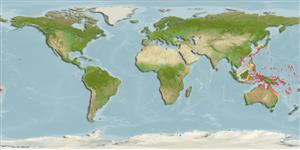Klassifizierung / Names
Namen | Synonyme | Catalog of Fishes(Gattung, Arten) | ITIS | CoL | WoRMS | Cloffa
>
Gobiiformes (Gobies) >
Gobiidae (Gobies) > Gobiinae
Etymology: Amblygobius: Greek, amblys = darkness + Latin gobius = gudgeon (Ref. 45335); cheraphilus: Name from Greek 'cheraphilus' meaning 'mud-loving'; referrng to its mud and silt
habitat..
Environment: milieu / climate zone / depth range / distribution range
Ökologie
seewasser riff-verbunden; tiefenbereich 6 - 14 m (Ref. 114936). Tropical
Western Pacific: Papua New Guinea; Japan (Ryukyu Is.), Indonesia (Bali and Flores), Micronesia (Yap), but probably ranges widely in the East Indian Ocean.
Size / Gewicht / Alter
Maturity: Lm ? range ? - ? cm
Max length : 2.7 cm SL Männchen/unbestimmt; (Ref. 114936); 3.3 cm SL (female)
Kurzbeschreibung
Bestimmungsschlüssel | Morphologie | Morphometrie
Rückenflossenstacheln (insgesamt) : 7; Rückenflossenweichstrahlen (insgesamt) : 13 - 14; Afterflossenstacheln: 1; Afterflossenweichstrahlen: 13 - 14; Wirbelzahl: 26. This species is distinguished by the following characters: D VI + I,13-14; A I,13-14; caudal fin moderately lanceolate, in adults slightly longer than head length; longitudinal scales 56-60; transverse scales 15-17; body scales are entirely cycloid; scaleless on head except side of nape with 14-18 rows of cycloid scales; color when alive grayish with two dark reddish-brown stripes on head and body; the upper stripe across snout, through mid-eye, ending below middle of soft dorsal fin, while the lower stripe from rear maxilla to middle base of caudal fin with portion on opercle containing a prominent oval dark-brown spot (usually larger than pupil) and stripe ending in a prominent triangular dark brown spot on caudal-fin base; small brown saddles along the back and across predorsal region; small (slightly less than pupil size) ocellus on the upper rays of caudal fin (Ref. 114936).
Life cycle and mating behavior
Maturities | Fortpflanzung | Spawnings | Egg(s) | Fecundities | Larven
Allen, G.R. and M.V. Erdmann, 2016. Descriptions of two new gobies (Gobiidae: Amblygobius) from the tropical western Pacific Ocean. J. Ocean Sci. Found. 24:10-23. (Ref. 114936)
IUCN Rote Liste Status (Ref. 130435)
Bedrohung für Menschen
Harmless
Nutzung durch Menschen
Tools
Zusatzinformationen
Download XML
Internet Quellen
Estimates based on models
Phylogenetic diversity index (Ref.
82804): PD
50 = 0.5000 [Uniqueness, from 0.5 = low to 2.0 = high].
Bayesian length-weight: a=0.00708 (0.00333 - 0.01504), b=3.09 (2.92 - 3.26), in cm total length, based on LWR estimates for this (Sub)family-body shape (Ref.
93245).
Trophic level (Ref.
69278): 3.0 ±0.2 se; based on size and trophs of closest relatives
Widerstandsfähigkeit (Ref.
120179): hoch, Verdopplung der Population dauert weniger als 15 Monate. (Preliminary K or Fecundity.).
Fishing Vulnerability (Ref.
59153): Low vulnerability (10 of 100).
